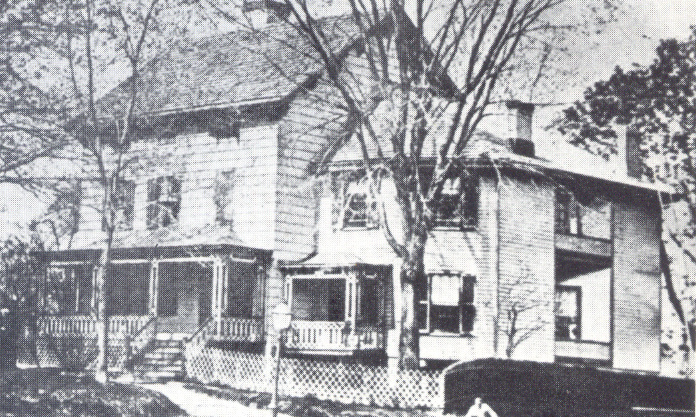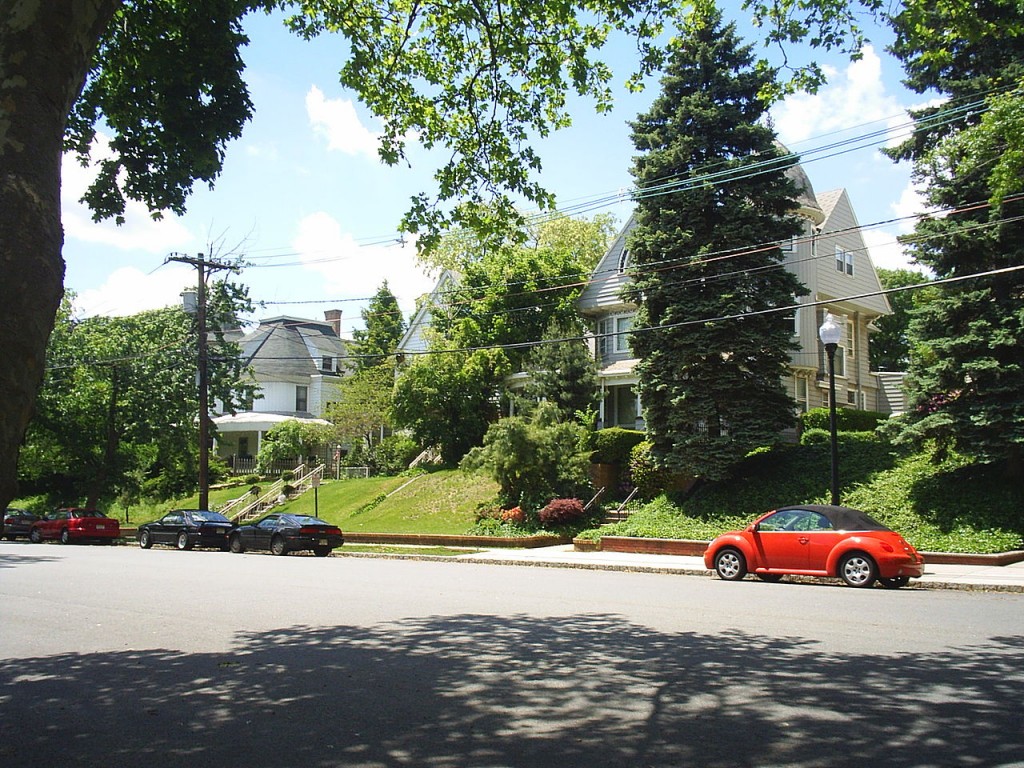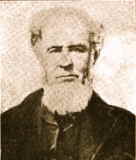*Note: Some of the language below may be a little antiquated because its excerpts and transcriptions from a the book -Transcription from Historic Houses of New Jersey By Weymer Jay Mills .J. B. Lippincott Company – written in 1902 = The original words provide a unique glimpse of the people and early times in New Jersey
The next residence to the cottage of Madame Scribblerus in Perth Amboy, New Jersey, in antiquity and interest is the venerable dwelling so well loved by all old Amboy residents as the abode of the Smith family, after whom Smith Street is named.
Typical Victorian houses on Smith Street, Perth Amboy, NJ
The queer and eccentric Thomas Bartow
This old house has a large share of romantic interest in being the home of the queer and eccentric Thomas Bartow, a gentleman of wealth and culture, whose friendship for the youthful William Dunlap in the days before the Revolution is said to have laid the foundation of the artistic knowledge which eventually made him one of New York City’s most famous theatrical managers and art-critics.
RIBBON OF LOVE: 2nd edition – A Novel Of Colonial America: Book one in the Tapestry of Love Series
Thomas Bartow at that time, just before the Revolution, was a very old man. Dunlap himself in after years described him as “a small, thin old man, with straight gray hair hanging in comely guise on each side of his pale face.”
Mystery in wrong he had done a woman
Tradition says that owing to some mystery in connection with the wrong he had done a woman in youth he lived in strict seclusion, no females but his relatives and a black woman as venerable as himself ever crossing his threshold. But perhaps his relatives made amends for the rest of the fair sex, for he had many, and interesting ones.
Niece was Mrs. Aaron Burr
First of all in the white light of history stands his lovely niece, Theodosia Prevost, afterwards Mrs. Aaron Burr. She was the daughter of his brother, Theodosius Bartow, who married Ann Stilwell. He was a lawyer and native of Shrewsbury, New Jersey, and it was there that the woman whose charm excelled that of every other member of her sex, according to Burr, passed her early youth until she was wooed and won by Captain Frederick Prevost, a relative of Lieutenant General Sir George Prevost, Baronet.
She must have often visited the old gentleman with her mother, Mrs. Philip de Visme,* for he left her in his will ” one hundred pounds in Spanish milled dollars, at eight shillings each, for the use of her children,” which was a large legacy. *Then there were the five daughters of his brother Theophilus, who resided in Westchester County, New York, and his sister, Margaret Pell, besides all his little grandnieces.
In his house, large for one solitary man, he lived a quiet life in the midst of a treasure collection of books and prints, added to on the arrival of every one of those old-time English and French merchantmen which put in at Amboy.
Thomas Bartow House, Perth Amboy, NJ
Happy hours spent in the garden
It is not hard to realize how the bright-faced boy who dwelt close by at first attracted him as his little nankeen-clad figure passed his windows’ or looked longingly into his garden, and then, as he grew to know him, crept into his heart.
There in that old garden, still beautiful in summer, under the many shading fruit-trees and surrounded by bright flowers, they together used to look over the plays of Otway, Foote, Banks, Farquhar, and many other dramatists of the time.) Gladly the youthful Dunlap would listen to the tales of the London world Bartow had once known, of Drury Lane and the great actresses, the fair Mrs. Pope as Cleopatra, and the great Mrs. Siddons as Isabella in “Measure for Measure,” and very often he tried to sketch a copy of some copper-plate the work of Hogarth or a later master.
Dunlap, in writing a chapter on his life in the ” History of the Arts of Design in the United States,” says of these visits: “It is not irrelevant to dwell upon my visits to this good old gentleman.
The happy hours passed with him in his garden, or in walking with him, or in our rides might be omitted, but when I found him on that Sunday morning when the parson, a regimental chaplain who was engaged to bestow his spare time on the Episcopalians at Woodbridge and Amboy, was absent from the latter place, when I was received and placed by the side of the old gentleman at the stand or table where he sat with his books, when after going up-stairs to the book-closet and bringing down such volumes as struck my fancy, I received his explanations of the pictures on the pages; if these were passed over I should omit the happiest moments of my childhood, and of hours which expanded my intellect and laid the foundation of my love for books and pictures.”
Pictures of Bartow and his young friend exist
In the stories of the ancient capital there are other pictures of Bartow and his young friend. It is said that the old gentleman was a frequent visitor to the mineral spring, situated a few miles out of town, and whose waters were credited with the medicinal qualities of the German Spa. Rude seats had been built around it, and there aristocrats of Amboy came by chair or on foot in the summer-time. Bartow must have often been rudely startled by the appearance of some aristocratic dowager, sent there by a tactful physician, or a bevy of fair girls on a pleasure excursion; and no doubt he took to his heels on many an occasion.
We can see him hurrying away in the riding-chair he left in his will to Bathsheba, ” the widow of my brother Theopilus,” with little Dunlap, who would rather have remained to see the new arrivals, and on the way homeward over the King’s Highway meeting a party of huntsmen with “Heards hounds,” famous in Amboy and Woodbridge. Of Heard himself Dunlap has left us a description, calling him “a dignified and venerable personage in a scarlet coat, black jockey-cap, broad leather belt, and hunting-horn.”
Many stories about the old man
Many other tales could the old house tell of aged Bartow and his young friend. How the boy, urged on by him, went to the great Franklin Palace at the end of the street to sketch the comely lady of the last royal governor. Of the handsome young officers who sometimes laughingly sat for him in those sombre days after the battles of Trenton and Princeton, when Amboy was filled to overflowing with the flower and pick of the British army. Of the consolation the old man was to him when he endured the great affliction of losing one of his eyes, the result of some boyish sport.
Of the letter he wrote to his friend from Rocky Hill after the great conqueror, Washington, permitted him to begin a picture of him; and, last of all, the final glimpse of old Bartow and his weeping servants, Robert Fitzharding, a bound boy, and his old negress, saying good-by to the house they loved so well.
The precious books and prints are on their way to the Moravian town of Bethlehem, Pennsylvania, where it is said an expectant and unacknowledged family awaited him. * The Revolution is over, bringing its cruel knowledge to many a Royalist household, and yet the birds of Amboy sing gayly and the sun shines as brightly as ever on good Plenty and her golden horn on the knocker of the old homestead as Bartow in his chaise turns the corner and obtains the last glimpse of his Jersey home. The next owner of the Bartow House was James Hude Kearny.
Link to Kearney and Amboy families
It is with his name, a corner-stone in Amboy history, and that of his daughter, Gertrude Parker Kearny, who married Charles McKnight Smith, that the old house is linked in the minds of the few old Amboy families now left. Charles McKnight Smith, who was a great-grandson of William Smith, the first Yale graduate to practice law in America, was a physician.
A physician in a country town before the fifties had to endure more hardships than his brethren of to-day ever dream of. There were no steam-engines to facilitate travel then, and the doctor and his gig on the highways and lanes of the surrounding country, under sun and stars, summer winds or the chill blasts of winter, was a heroic figure, but an unappreciated one.
Dr. Charles McKnight Smith
She helped prepare history of Perth Amboy
In the drawing-room of the Bartow House, with its old furniture and mellow-tinted rugs, is a beautiful portrait of him. He is wearing a great-coat and a high white stock, and his eyes seem to be gazing out of the room’s many windows on the trees which guard the quiet streets he knew so well. Streets somewhat changed since he hurried over them on his errands of mercy, a true physician of the old school. Across the room from him hangs the likeness of the sweetfaced lady who was his wife. She was a lover of every inch of Amboy and all its traditions, and it was with her help that William Whitehead, the historian, whose great work for New Jersey can never be estimated, prepared his history of Perth Amboy.
In her room, where years before Bartow sometimes entertained the youthful Dunlap, and which echoed to that silvery voice of Theodosia Provost, there are preserved her ancient curtained bed, the Franklin stove, the empty candle-stick, the old gold watch, sent as a present to her father from England in the eighteenth century, and all the many accessories of a lady of yesterday.
The quaint panelled dining-room still speaks of her presence. The sunbeams that steal in through its little casements over the Delft jars filled with growing geranium plants light up one of the most interesting rooms in America.
The spindle-legged chairs and tables are of a design first made famous by Chippendale. The massive iron dogs before the blue-tiled fireplace bear the date 1669, and the pieces of plate on the sideboards are almost their match in age, many of them having been made during the reign of Queen Anne.
On the green by the house, where the geese of the neighborhood used to wander, her husband’s little office still stands. No more can those mute pictures gaze out at the patients coming there. The timorous ladies in short skirts and tarletans and turbans and sun-bonnets of Paris straw, followed by their black girls, almost the way the great Mrs. Pepsys used to walk abroad in her London of one hundred and fifty years earlier. The door of the little house is shut forever, and the gentle ladies of the long ago have joined the silent company by St. Peter’s.
* Theodosius Bartow died shortly before the birth of his child, whom he wished named after himself; but as she was a female, she was called Theodosia. His widow married Philip de Visme, of a noble French family, and the two families, De Visme and Provost, resided during the Revolution in the ” little Hermitage” at Hokokus, New Jersey.
There Lieutenant-Colonel Burr became acquainted with them while stationed in the vicinity. He married Theodosia Provost, then in the height of her charms, in the Dutch Church, a mile or so distant. Among the bequests in his will are the following: “To William Dunlap, son of Saml. Dunlap of Perth Amboy the sum of fifty pounds—towards placing of him to a merchant, or such other calling as his parents or guardians think fit.
“To William Burnet—a gold ring for a remembrance, of the value of a guinea.
“All my household goods, furniture utensils and other things which I left, and my desk at Thomas Potter’s on the sea shore, to the daughters of my brother Theophilus, to be divided among them in such manner and proportions as their mother shall think fit.
“To my sister Margaret Pell two silver table spoons, six tea spoons, and a tea-tongs; with tea chests and cannisters.”
* Thomas Bartow, in his will, made May 12, 1779, gave his house in Perth Amboy to his son Thomas, a resident in Philadelphia. This son Thomas married Sarah Benezet, the daughter of Daniel Benezet (not Anthony, his brother, as Mr. Whitehead has it). His wife’s grandfather was John Stephen Benezet, and the family was very rich and distinguished. He threw open his large house for Count Zinzindorf when he came to America to preach, and greatly aided in establishing the Moravian Church in Philadelphia.
SOURCE
- Transcription from Historic Houses of New Jersey By Weymer Jay Mills .J. B. Lippincott Company, 1902
- Library of Congress
Click here to Join Amazon Kindle Unlimited 30-Day Free Trial  and choose from over one million Ebooks to read for FREE!
and choose from over one million Ebooks to read for FREE!
Three complete historical novels for $11.97! Tapestry of Love Historical Series 2nd edition 2016
Court records dating back to the 1630s create historical accuracy as the reader is taken back to the primitive days of colonial Virginia and Maryland where the Pattendens encounter life-changing difficulties with Indians, ducking stools, illness, massacres, death, loneliness, love, and greed.
READER REVIEW OF RIBBON OF LOVE: 2nd edition – A Novel of Colonial America Book one: The exhilarating action and subplots keep the reader in constant anticipation. It is almost impossible to put the book down until completion. – Dr. Don P. Brandon, Retired Professor, Anderson University







